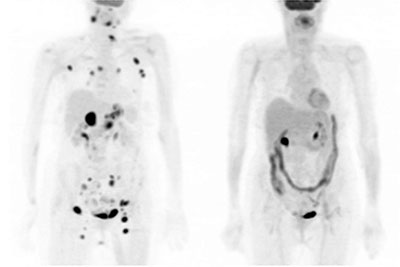
Context
Medical care benefits from early explorations improving the diagnosis of pathologies that would be incurable or difficult to treat at a later stage. These explorations also make possible to better evaluate the effects of treatments in order not to maintain unnecessary complications and side effects, and not to delay a therapeutic alternative which could be more effective. Medical models are evolving with the concept of personalization, adapting the care to each patient. At the individual level, diagnostic and therapeutic interactions are mainly supported by technological and scientific advances in the field of biomedical imaging, in particular to obtain a characterization of molecular signatures.
Molecular biomarkers and theranostic couples
Molecular changes associated with diseases precede morphological and structural changes.
The identification of molecular biomarkers is thus a key element in the early diagnosis and evaluation of diseases. These molecular signatures also evolve with the natural history of the disease, but also with the effects of treatments. They allow us to better assess the entire complexity of the disease at the level of each patient, and within the same subject at the level of each lesion. This molecular complexity is closely related to the prognosis, but also to the development of treatments specifically directed towards the same pathophysiological target for diagnosis and treatment. Through this approach, the companion drug concept has been extended to the field of theranostics (coupling diagnostic biomarker & therapy).
Molecular imaging in Nuclear Medicine
Molecular imaging in Nuclear Medicine is based on the selective deposition of a diagnostic physical agent on a biological target. The labeling of this agent with radioactive gamma or beta emitters makes it possible to locate the targets by the detection of single photons in SPECT (Single Photon Emission Computed Tomography) imaging or of pairs of photon in PET (Positron Emission Tomography) imaging. This diagnostic radiolabeling provides optimal sensitivity performance, with sub-picomolar detection after administration of picograms of tracers, without disturbing the environment to be explored. These non-invasive techniques are particularly relevant for exploring and monitoring the molecular signatures of multifocal lesion diseases (cancer, infection, inflammation), but also those of more functional pathologies (clinical neurosciences, particularly in psychiatry). These quantitative biomarkers are used in a personalized approach to select patients, and guide, predict, evaluate the most appropriate treatments, including emerging therapies, based on the characterization of molecular signatures obtained at the individual scale.

Objectives of the IMoTheP team
The IMoTheP team (Molecular Imaging for Personalized Theranostic Applications) includes clinical physicians (neurologist, psychiatrists) and imaging physicians (nuclear physicians), biomedical physicists / technicians, a clinical research assistant and a project manager (DHU-Imaging), from APHM, in interaction with the CERIMED imaging platform, around the general theme of Health Technologies. The objective is to promote, in a translational approach, methodological development, transfer and innovative application in biomedical molecular imaging. The problematic includes signal detection and image analysis, but also the joint use of theranostic therapeutic approaches. Theranostics are developed and implemented here in the fields of clinical neurosciences, inflammatory/infectious diseases, and cancerous tumors, with particular attention to their interfaces.


 ResearchGate
ResearchGate Flux RSS
Flux RSS